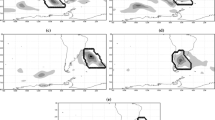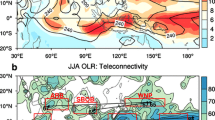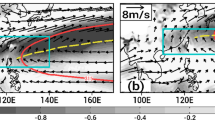Summary
¶An examination is made of the relationships between circulation and convection over South America as related to strong cooling in southern and southeastern Brazil during austral wintertime. Correlations between sub monthly (2–30 days) near-surface air temperature in southeastern Brazil reveal the preferred path of a quasi-stationary Rossby wave impinging on to the region from mid-latitudes and emanating from the tropical western Pacific. The large amplitude upper-level trough in middle latitudes, which extends into the tropics, has been pointed out as one of the major features of the cold situation. These waves embedded in westerly flow are an example of wintertime tropical-extratropical interactions leading to cooling in southeastern South America. This is suggested by the results from the observational and baroclinic-modeling studies presented here. However, in addition to the right synoptic situation associated with this intermediate modulation, local controls are important on determining the degree of cooling and the occurrence of freezes.
Similar content being viewed by others
Author information
Authors and Affiliations
Additional information
Received August 25, 2000; revised September 1, 2001; accepted December 1, 2001
Rights and permissions
About this article
Cite this article
Marengo, J., Ambrizzi, T., Kiladis, G. et al. Upper-air wave trains over the Pacific Ocean and wintertime cold surges in tropical-subtropical South America leading to Freezes in Southern and Southeastern Brazil. Theor. Appl. Climatol. 73, 223–242 (2002). https://doi.org/10.1007/s00704-001-0669-x
Issue Date:
DOI: https://doi.org/10.1007/s00704-001-0669-x




